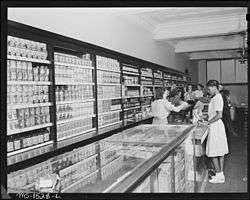Company store
A company store is a retail store selling a limited range of food, clothing and daily necessities to employees of a company. It is typical of a company town in a remote area where virtually everyone is employed by one firm, such as a coal mine. In a company town, the housing is owned by the company but there may be independent stores there or nearby.
The store typically accepts scrip or non-cash vouchers issued by the company in advance of weekly cash paychecks, and gives credit to employees before payday. Except in very remote areas, company stores became scarcer after the miners bought automobiles and could travel to a range of stores. Even so, the stores could survive because they provided convenience and easy credit.
Company stores have had a reputation as monopolistic institutions, funnelling workers' incomes back to the owners of the company. Company stores often faced little or no competition and prices were therefore uncompetitive. Allowing purchases on credit enforced a kind of debt slavery, obligating employees to remain with the company until the debt was cleared.
Regarding this reputation, economic historian Price V. Fishback wrote that:
The company store is one of the most reviled and misunderstood of economic institutions. In song, folktale, and union rhetoric the company store was often cast as a villain, a collector of souls through perpetual debt peonage. Nicknames, like the "pluck me" and more obscene versions that cannot appear in a family newspaper, seem to point to exploitation. The attitudes carry over into the scholarly literature, which emphasizes that the company store was a monopoly.[1]
(The songs Fishback mentions include the popular folk song "Sixteen Tons," which includes such lines as "Saint Peter, don't you call me, 'cuz I can't go. I owe my soul to the company store.")
Company stores existed elsewhere than the United States, in particular in the early 1900s in Mexico, textile workers at the largest cotton mill were paid in scrip. In 1907 workers attacked and looted the Río Blanco, Veracruz textile company's store. The workers were gunned down by the Mexican military, but in the aftermath of the violence, more retail outlets were opened in Rio Blanco.[2]
The stores served numerous functions, such as a locus for the government post office, and as the cultural and community center where people could freely gather.[3]
See also
Notes
- ↑ Price V. Fishback, Soft Coal, Hard Choices: The Economic Welfare of Bituminous Coal Miners, 1890-1930 (1992) p 131
- ↑ John Kenneth Turner, Barbarous Mexico (1910) reissued by University of Texas Press, 1969, pp. 169-174.
- ↑ Lou Athey, "The Company Store in Coal Town Culture," Labor's Heritage (1990) 2#1 pp 6-23.
Further reading
- Athey, Lou. "The Company Store in Coal Town Culture," Labor's Heritage (1990) 2#1 pp 6–23.
- Crawford, Margaret. Building the Workingman's Paradise: The Design of American Company Towns (1996)
- Fishback, Price V. "Did Coal Miners 'Owe Their Souls to the Company Store'? Theory and Evidence from the Early 1900s," Journal of Economic History (1986) 46#4 pp 1011–29 in JSTOR; also in Price V. Fishback, Soft Coal, Hard Choices: The Economic Welfare of Bituminous Coal Miners, 1890-1930 (1992) ch 8 online
- Green, Hardy. The Company Town: The Industrial Edens and Satanic Mills That Shaped the American Economy (2010) excerpt and text search
- Martin, Cynthia Burns. "The Bodwell Granite Company Store and the Community of Vinalhaven, Maine, 1859-1919, Maine History (2012) 46#2 pp 149–168. Located on Vinalhaven Island, Maine, 1859 to 1919
- Tucker, Gene Rhea, and Richard Francaviglia. Oysters, Macaroni, and Beer: Thurber, Texas, and the Company Store (2012), the store--and the whole town, were owned by the Texas and Pacific Coal Company
- United States Bureau of Labor; Carroll Davidson Wright (1893). Analysis and index of all reports issued by bureaus of labor statistics in the United States prior to November 1, 1892. Government Printing Office. p. 264. - guide to state studies of company stores in the 1880s
